With its Bosch motor and 625 Wh battery, the Trek Rail 9.9 X01 is an old acquaintance in our group test. This year’s model enters the race with a few small updates and brand new suspension. Despite the massive stanchions of the new fork, the bike is very light. But is that enough for a test victory and can the Trek finally secure the coveted Best in Test of this year’s big group test?
For an overview of the test fleet head to the group test: The best eMTB of 2021 – 25 models in review
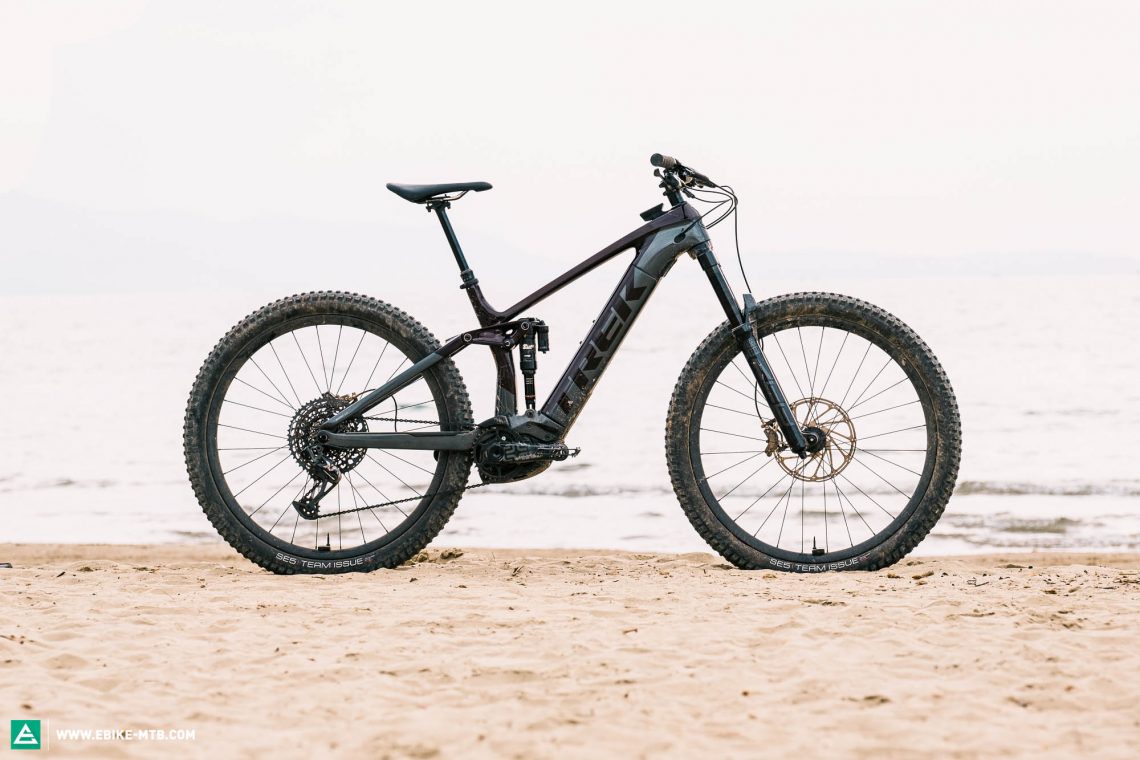
22.60 kg in size L | € 10,499 | Manufacturer’s website
The elegant Trek Rail already impressed our test team last year with its high-quality carbon frame and seamless integration of the Bosch motor. While the 2021 model has remained pretty much unchanged, it’s still one of the most impressive Bosch bikes in this year’s test field. The internal 625 Wh battery can be removed from the side of the down tube within seconds and the Kiox display is elegantly mounted on the top tube, rather than sitting on top of the handlebars or stem where it would be exposed to impacts like all other Bosch bikes in this test. In its position, the display is well protected from impacts both in the event of a crash and during transport. Only the cable routing along the frame to the display could have been better solved. For the charge port and speed sensor, Trek have developed their own parts rather than settling for Bosch’s flimsy components. The signature Trek look of the 22.6 kg Rail is rounded off by a spectacular paint finish that literally comes to life in the sunlight.
Trek don’t do themselves any favours with their own tires: The spec of the Rail 9.9
Retailing at € 10,499, the Trek Rail 9.9 features RockShox suspension with a 160 mm RockShox ZEB fork taking care of the front and Super Deluxe Ultimate ThruShaft shock managing the rear end. Specially designed for Trek bikes, the shock has fewer seals and is claimed to allow super responsive rear suspension. SRAM Code RSC brakes with 220/200 mm rotors provide reliable and powerful deceleration and have consistently proved the best-performing brakes in the entire test field. The Bontrager carbon cockpit, dropper post and carbon wheels are all in-house components. Except for the dropper remote, they’re all light, functional and built to the highest quality. Unfortunately, the same cannot be said about the Bontrager 2.6″ SE5 tires, which offer no traction whatsoever and are very puncture prone too. We recommend upgrading your tires right away. One cool addition is the Quark TyreWiz sensors, which read your tire pressures. Particularly with expensive carbon rims, this system makes total sense, allowing you to check your pressures on the go and prevent rim strikes.
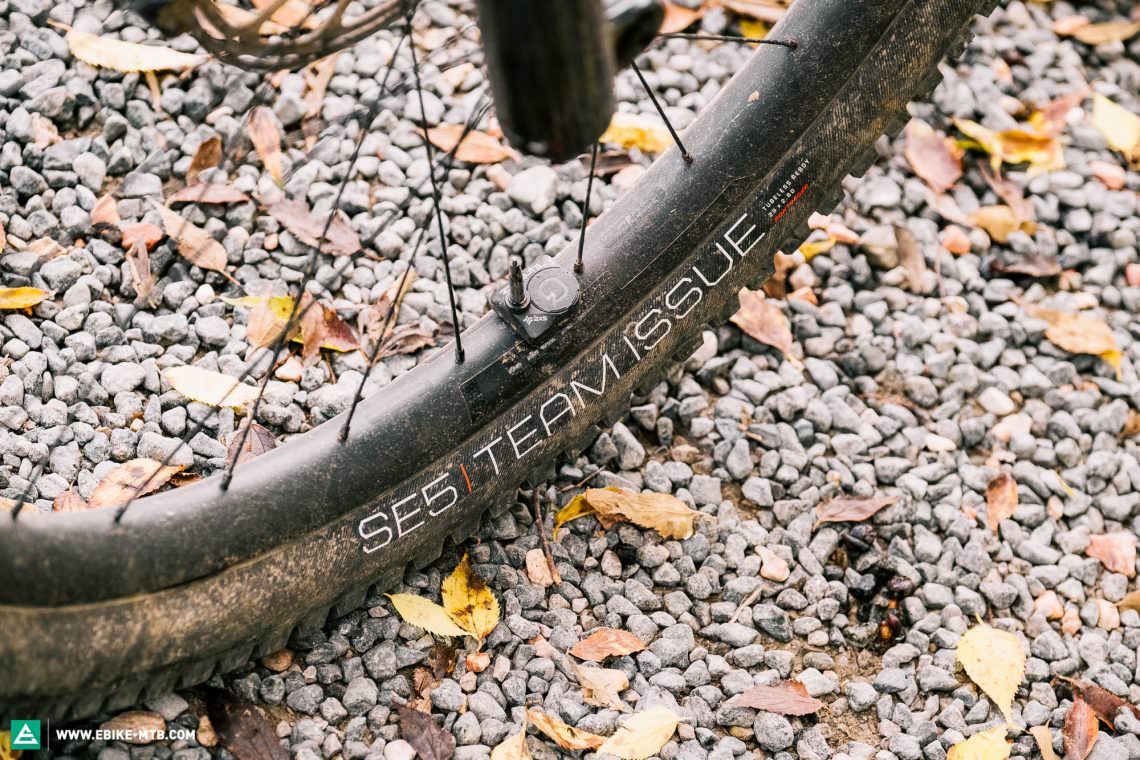
The low-profile and puncture-prone Bontrager SE5 tires limit the potential of theTrek immensely. With the integrated TyreWiz pressure gauge, you can check the right pressure on the go and protect your rims from heavy blows.

Trek sidestep Bosch by using their own and significantly smaller speed sensor. This is integrated in the dropout and relies on a magnet attached directly to the brake rotor. The Rail also has a kickstand mount.

The ThruShaft shock and rear end of the Rail are perfectly tuned: the bike is extremely responsive and still provides tons of support and huge reserves.

The metallic wine-red finish looks incredibly beautiful and literally comes to life in the sunlight. Unfortunately, the gorgeous finish is susceptible to damage. After just one long day in the rain, the paint job of our test bike got scratched. We recommend using a frame protector.
Trek Rail 9.9 X01
€ 10,499
Specifications
Motor Bosch Performance Line CX 85 Nm
Battery Bosch PowerTube 625 Wh
Display Bosch Kiox
Fork RockShox ZEB Ultimate 160 mm
Rear Shock RockShox Super Deluxe Ultimate RT3 150 mm
Seatpost Bontrager Line Elite 170 mm
Brakes SRAM CODE RSC 220/200 mm
Drivetrain SRAM X01 Eagle 1x12
Stem Bontrager Line Pro 45 mm
Handlebar Bontrager Line Pro 780 mm
Wheelset Bontrager Line Elite 30 29"
Tires Bontrager SE5 Team Issue 2.6"
Technical Data
Size S M L XL
Weight 22.60 kg
Perm. total weight 136 kg
Max. payload (rider/equipment) 113 kg
Trailer approval no
Kickstand mount yes
Specific Features
TyreWiz
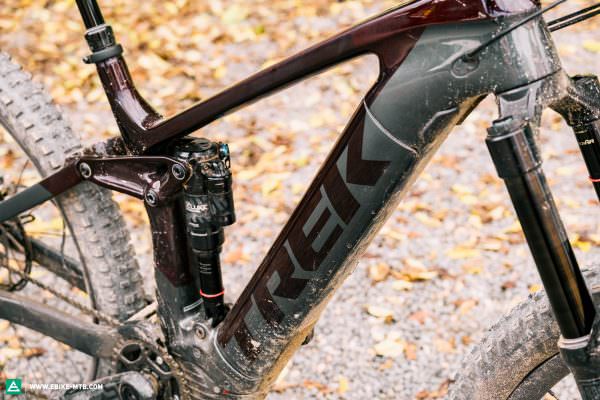
The 625 Wh battery is very easy to remove from the side of the down tube. This is possible thanks to a clever locking system and a practical handle.

Many handlebar- and stem-mounted Kiox displays and holders gave up during our test. Instead, the Trek’s Kiox display is cleverly placed on the top tube where it’s less susceptible to knocks, both on and off the trail. However, readability and cable routing could still be improved.
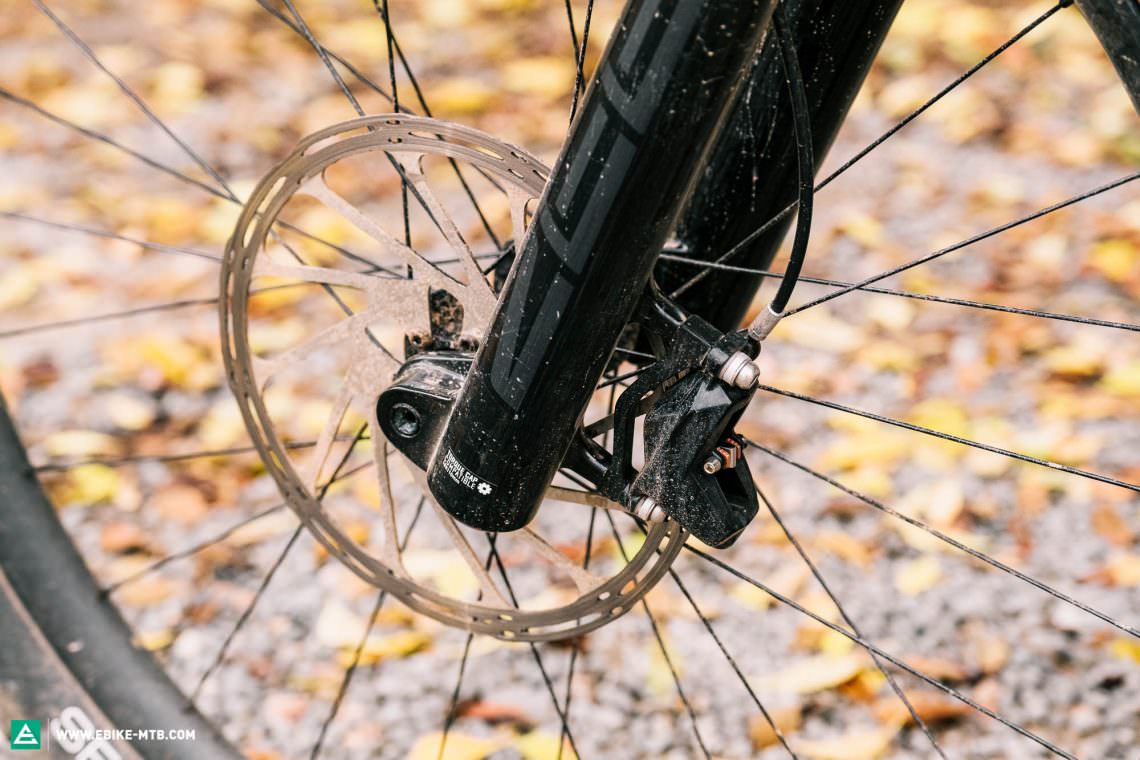
Trek pair SRAM’s Code RSC brakes with 220/200 mm (f/r) rotors. Stopping power, modulation and reliability? Check!
A flip chip allows for minor geometry adjustments. Depending on the setting, the seat tube angle varies by around 0.5°. As a result of the pronounced kink in the seat tube, its 77.5° angle is simply too slack, with the effective seat tube angle slackening ever further as the dropper extends. Riders with long legs will find themselves sitting back over the rear wheel and should push the saddle all the way forward, regardless of the geometry setting. Even then, the riding position is anything but compact, especially on flat terrain. If anything, the riding position is sporty but not uncomfortable. However, the Trek prefers sporty adventures over long rides.
| Size | S | M | ML | L | XL |
|---|---|---|---|---|---|
| Seat tube | 395 mm | 420 mm | 435 mm | 450 mm | 500 mm |
| Top tube | 584/ 585mm | 609/ 610mm | 628/ 629mm | 647/ 649mm | 683/ 684mm |
| Head tube | 100 mm | 100 mm | 105 mm | 115 mm | 140 mm |
| Head angle | 64.6°/ 64.1° | 64.6°/ 64.1° | 64.6°/ 64.1° | 64.6°/ 64.1° | 64.6°/ 64.1° |
| Seat angle | 67.1°/ 66.6° | 67.1°/ 66.6° | 67.1°/ 66.6° | 67.1°/ 66.6° | 67.1°/ 66.6° |
| Chainstays | 435/ 437 mm | 435/ 437 mm | 435/ 437 mm | 435/ 437 mm | 435/ 437 mm |
| BB drop | 22/ 29mm | 22/ 29mm | 22/ 29mm | 22/ 29mm | 22/ 29mm |
| Wheelbase | 1197/ 1197 mm | 1212/ 1222 mm | 1242/ 1243 mm | 1263/ 1264 mm | 1304/ 1305 mm |
| Reach | 431/ 425 mm | 456/ 450 mm | 474/ 469 mm | 491/ 486 mm | 521/ 516 mm |
| Stack | 618/ 621 mm | 618/ 622 mm | 622/ 626 mm | 631/ 635 mm | 654/ 658 mm |
*Data for the Flipchip positions high/ low
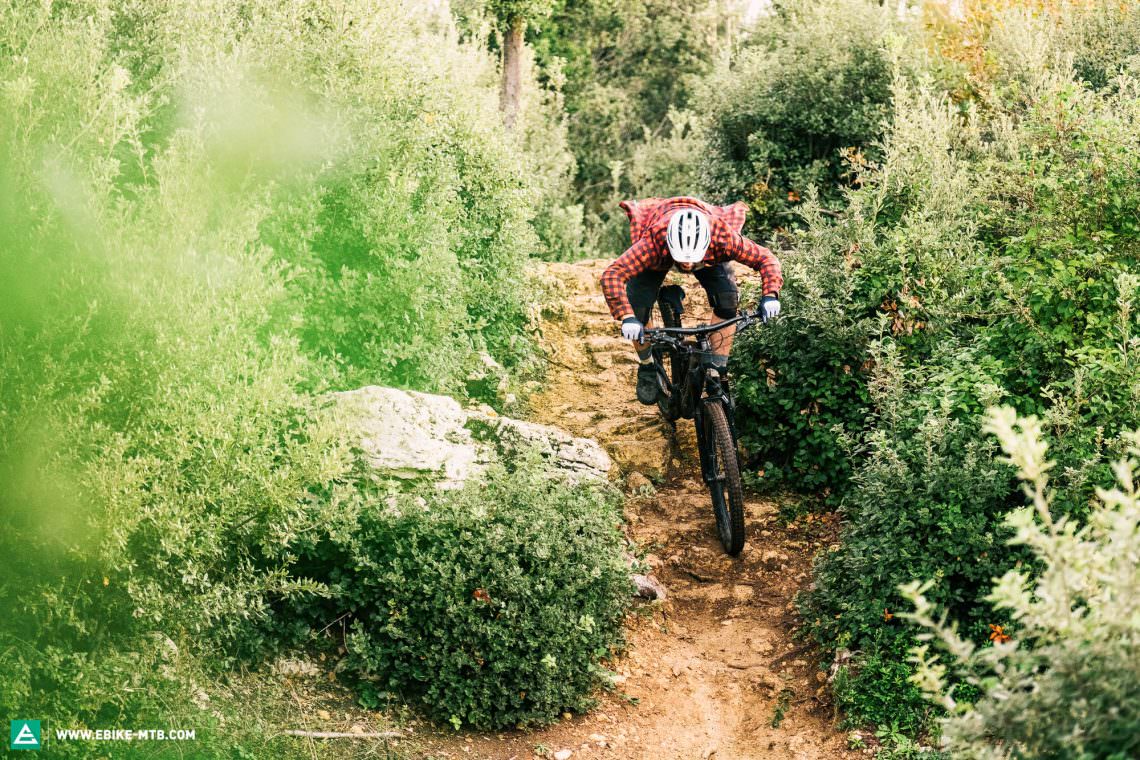
Jersey Zimtstern PureFlowz | Shorts Zimtstern Trailstar Evo
Kneepad POC Joint VPD System Knee | Shoes Leatt DBX 4.0 | Gloves POC Essential
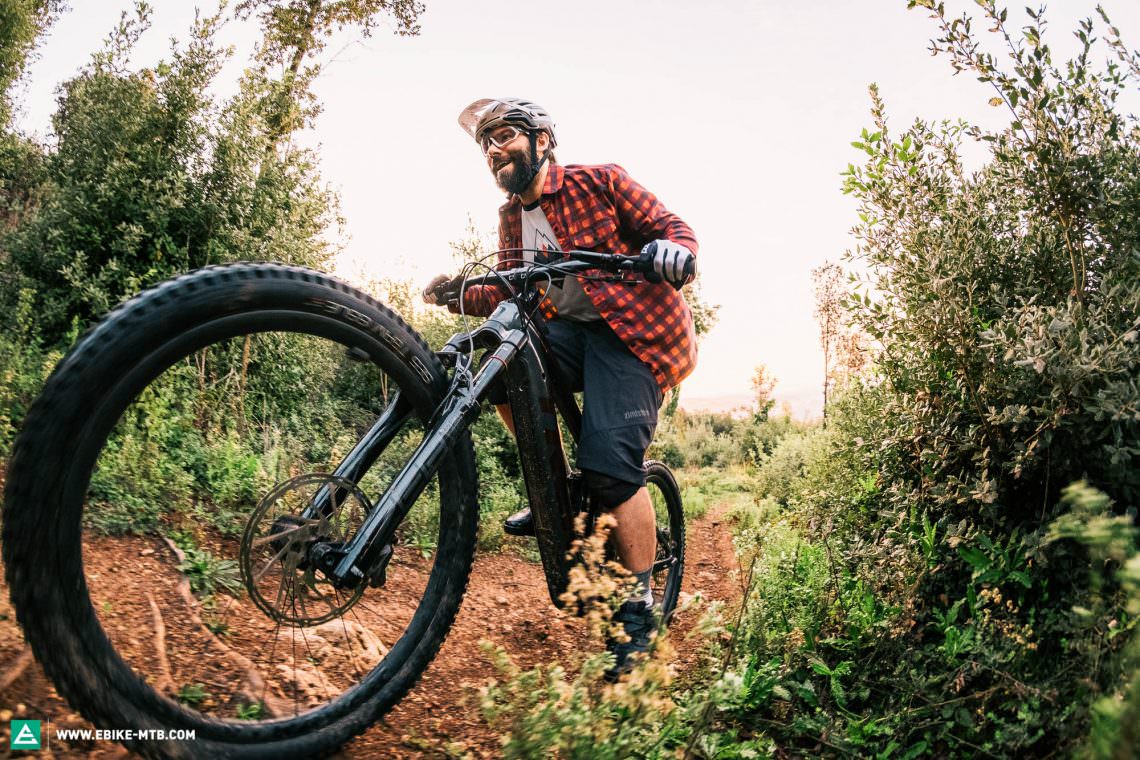
Uphill, the Rail requires great physical effort to keep the front wheel tracking. If you manage to do so, it’s playful and fun to ride.
Flowing trails, downhill tracks or both? Downhill, the Trek Rail convinces in every situation
Depending on how high you run your saddle, the Trek places you either in a fairly central position or too far back over the rear wheel on climbs. If you’re in between sizes, you may want to consider sizing up. Apart from this, the bike is nimble and agile on narrow and winding climbs. Thanks to the powerful Bosch motor and lightweight wheelset, the Rail accelerates willingly out of corners and is fun to ride. Only on steep climbs and in slippery conditions does the Trek require more physical effort and good riding technique. The shock sits high in its travel and helps you to actively load the front end, preventing it from lifting. However, this position can cause the rear to spin out of control. Uphill, the SE5 tires quickly fail to generate enough traction and struggle to keep up with the huge potential of the Rail 9.9. When negotiating steps and obstacles on technical climbs, you’ll have to time your pedal strokes carefully to avoid clipping your cranks.
Downhill, the Trek Rail 9.9 is a master of all trades and strikes a perfect balance between agility and stability!


Tuning tips: tires with more grip and better puncture resistance | push the saddle all the way forward
If you want to ride fast on all sorts of descents and have fun in the process, the Trek Rail 9.9 might be exactly what you’re looking for. Whether you’re racking up high-speed party laps at your local bike park or traversing the Alps on technical terrain and flowing trails, the Rail 9.9 shines on all kinds of terrain and knows no limits, unless it’s raining. On wet, slippery trails, the tires struggle to generate enough grip and spoil the party – but hey, you changed the tires straight away, didn’t you? 🙂 Hardly any other bike in this test offers as much support and feedback while delivering such a sensitive response and generous reserves at high speeds. Seasoned riders, in particular, will appreciate the low bottom bracket, which rewards an aggressive riding style with tons of speed and plenty of fun. However, the Trek also requires an active and clean riding style in open, flat corners to generate enough grip on the front.
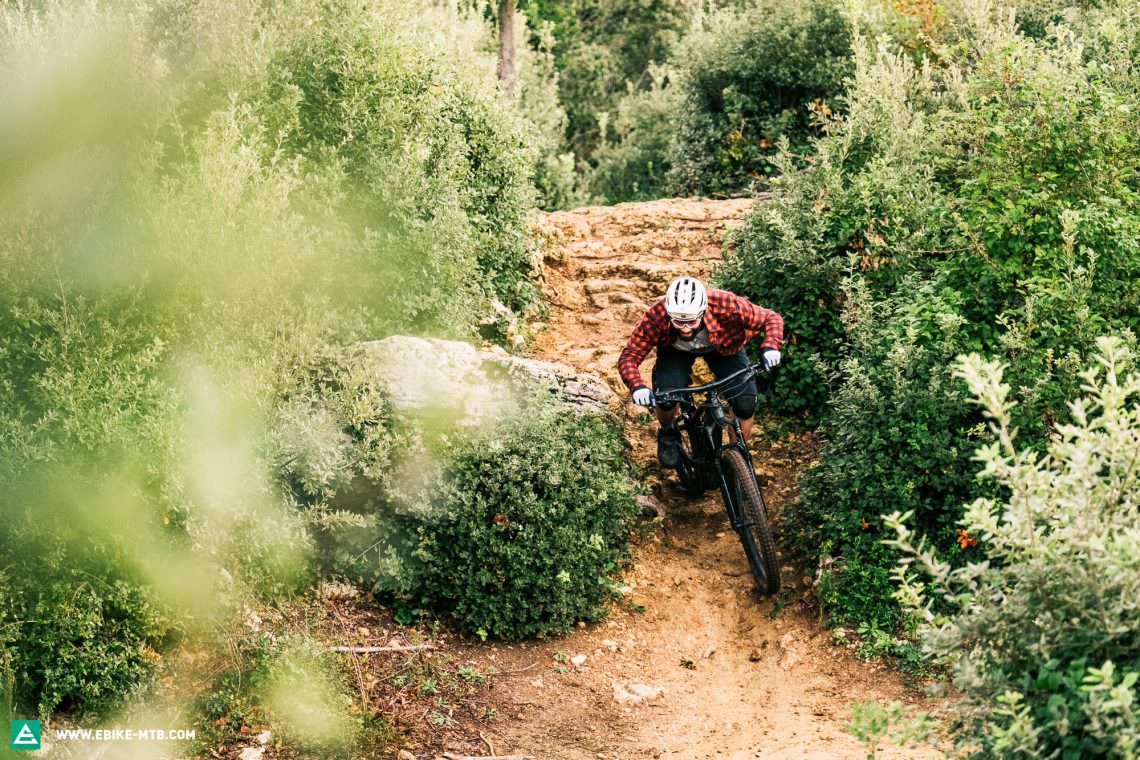
A split second before hitting this nasty compression at Mach 10, Jonas briefly regretted not writing his will. However, the Rail took the hit with composure and immediately asked for even more speed.
Riding Characteristics
7Agility
- sluggish
- playful
Stability
- nervous
- stable
Handling
- demanding
- balanced
Riding fun
- boring
- lively
Motor feeling
- digital
- natural
Motor power
- weak
- strong
Value for money
- poor
- top
Conclusion
The Trek Rail 9.9, stands out from the crowd for its killer looks, seamless integration of the Bosch system and, most importantly, outstanding handling. While it demands an active riding style, this is rewarded with a harmonious balance between playful handling and high-speed composure. It feels at home descending and is happy to take on any trail. However, we recommend replacing the Bontrager tires straight away.
Tops
- constantly invites you to play with the trail
- master of all trades downhill
- high-quality frame details
Flops
- tires
- pronounced kink in the seat tube
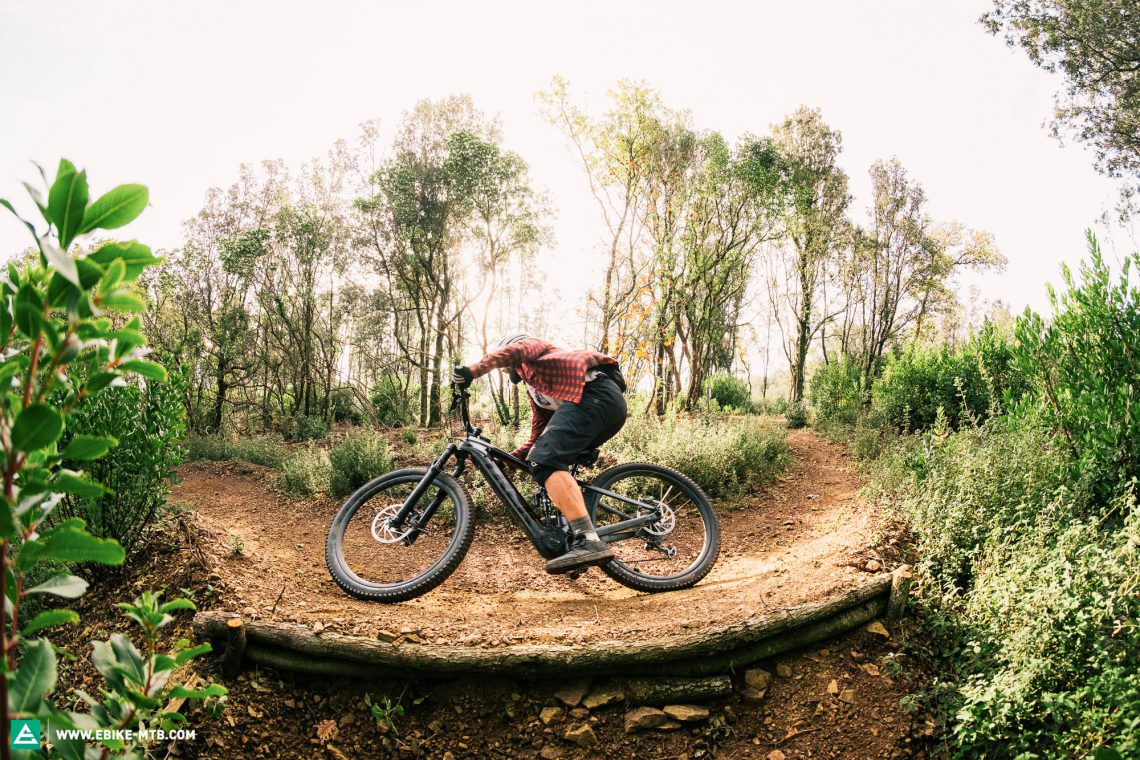
You can find out more about at trekbikes.com
The test field
For an overview of the test fleet head to the group test: The best eMTB of 2021 – 25 models in review
All bikes in this test: Cannondale Moterra Neo Carbon 1 (Click for review) | Canyon Spectral:ON CF 9 (Click for review) | CENTURION No Pogo F3600i (Click for review) | CUBE Stereo Hybrid 140 HPC SLT Nyon (Click for review) | CUBE Stereo Hybrid 160 C:62 SLT Kiox (Click for review) | Ducati TK-01 RR (Click for review) | FLYER Uproc6 9.50 (Click for review) | FOCUS JAM² 6.9 NINE (Click for review) | GIANT Trance X E+ 1 (Click for review) | Haibike AllMtn 7 (Click for review) | KTM Macina Kapoho Prestige (Click for review) | Lapierre Overvolt GLP 2 Team (Click for review) | MERIDA eONE-SIXTY 10K (Click for review) | Mondraker Crafty Carbon XR (Click for review) | Moustache Samedi 29 Trail 8 (Click for review) | ROTWILD R.X375 ULTRA (Click for review) | Santa Cruz Bullit X01 RSV Air (Click for review) | SCOTT Ransom eRIDE 910 (Click for review) | SIMPLON Rapcon PMAX (Click for review) | Specialized S-Works Turbo Levo (Click for review) | Specialized S-Works Turbo Levo SL (Click for review) | STEVENS E-Inception AM 9.7 GTF (Click for review) | Thömus Lightrider E2 Pro (Click for review) | Trek Rail 9.9 X01 (Click for review) | Whyte E-150 RS 29ER V1 (Click for review)
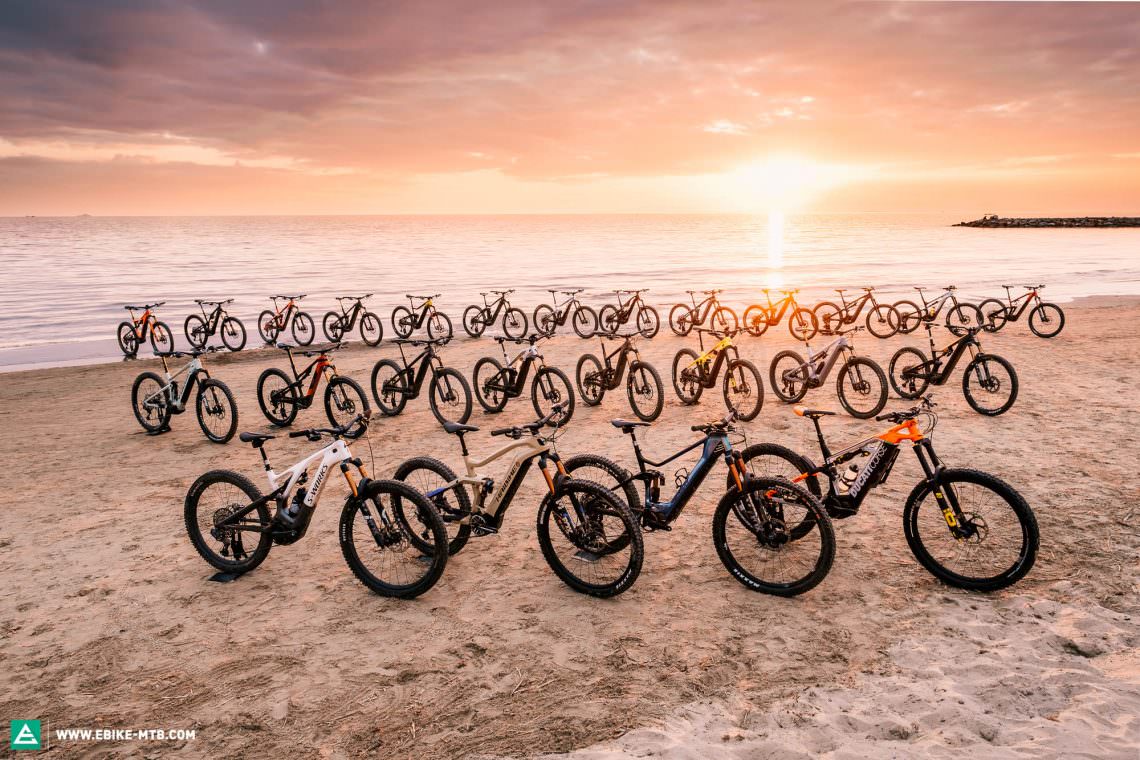
Relaxed and comfortable riding on surfaced roads, both uphill and downhill.↩
Easy climbs up trails with few obstacles, wide turns and a moderate incline.↩
Active and playful descents on easy trails with few obstacles, wide turns and a moderate slope.↩
Single-track climbs on challenging terrain. Loose ground, steps, roots, tight corners and occasionally extreme inclines.↩
Singletrack descents on challenging terrain. Loose ground, steps, roots, tight corners and small jumps as well as some very steep descents.↩
High speed descents on sometimes very rough trails with large jumps and obstacles that you can’t roll over.↩
The rating used for riding characteristics refers to the bikes in the group test and the current state of development of eMTBs. The best bikes managed to blend supposedly opposite riding characteristics, feeling both lively and stable at the same time. The handling describes the balance of the bike on downhill sections. The information regarding motor-power refers to the ride-feeling in the overall context of the bike and not exclusively to the motor – that’s why the same motor can present different values.↩
Did you enjoy this article? If so, we would be stoked if you decide to support us with a monthly contribution. By becoming a supporter of E-MOUNTAINBIKE, you will help secure a sustainable future for high-quality cycling journalism. Click here to learn more.
Words: Photos: diverse









